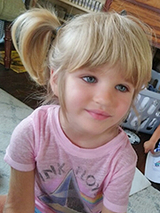Hyperinsulinism and Turner Syndrome: Aliza’s Story
Hyperinsulinism and Turner Syndrome: Aliza’s Story
Even before Aliza was born, her parents knew she had a high risk for Turner syndrome, a genetic condition, because of prenatal testing. But it wasn’t until Aliza was 14 months old that her family learned their little girl had frequent low blood sugar levels due to hyperinsulinism (HI), a rare disease that a small percentage of children with Turner syndrome also have.

"Once we learned about HI, everything Aliza was doing started to make sense,” says Aliza’s mother, Jaclyn.
Aliza was a fussy baby, until she ate. Then she’d conk out almost immediately. She would wake up early, and after eating a bite or two, she’d fall asleep in her high chair.
“Looking back on it, she just didn’t feel good because of low blood sugar,” Jaclyn says. “Once it was high enough, when she had food in her tummy, she’d relax.”
In-depth care available only at CHOP
The family lives in Cumberland County, about 2½ hours west of Philadelphia, an area with limited pediatric specialty care. It wasn’t until Aliza’s parents brought her to Children’s Hospital of Philadelphia (CHOP) that she received the in-depth care she needed to better manage both her Turner syndrome and hyperinsulinism.
About hyperinsulinism
One of her doctors had referred Aliza to CHOP’s Turner Syndrome Center, letting Jaclyn and dad Tristan know about the expertise available in Philadelphia.
Turner syndrome (TS), a chromosomal disorder in girls where one of the two X chromosomes is damaged or missing, is associated with poor growth, heart disease, absent puberty and, in some children, low blood sugar (hypoglycemia) caused by hyperinsulinism (when the pancreas releases too much insulin).
At Aliza’s first appointment with the Turner Syndrome Clinic, Vaneeta Bamba, MD, Medical Director of the Turner Syndrome Program, and Denise Gruccio, DNP, CRNP, PNP-BC, program nurse practitioner, suspected hypoglycemia when Jaclyn described Aliza’s routines. There was one scary morning when Aliza woke up early and Tristan brought her downstairs. He had to go to work, so made her some breakfast but she wouldn’t eat. She was just staring off into space, and then began to shake. A trip to the local emergency room yielded no answers, only a vague suggestion that she might have had a fever seizure. CHOP later said this probably was a seizure caused by extremely low blood sugar.
Consistent low blood sugar levels
Jaclyn followed the clinicians’ advice and bought a glucose (blood sugar) meter that day. She began testing Aliza’s blood several times a day. “It was consistently 30, 40, 30,” Jaclyn says. “After she ate, it would go up to 70 or 80, but then would drop back down pretty quickly.” A child’s glucose should be consistently in the 70 to 100 mg/dL range all the time.
When Jaclyn reported those low readings, Dr. Bamba referred her immediately to CHOP’s Congenital Hyperinsulinism Center, the largest such program in the world, which follows more than 30 girls who have both TS and HI. The HI Center researchers first described the association between HI and Turner syndrome in 2017. At CHOP, the HI and Turner centers’ experts collaborate with experts from genetics, nutrition, cardiology, ENT and psychology to address all the medical needs of these girls, providing comprehensive, evidence-based care.
The first step of treatment was to control Aliza’s low blood sugar. She was admitted to the Endocrinology floor at CHOP for a definitive diagnosis. When HI was confirmed through a diagnostic fast that demonstrated inappropriate insulin secretion/actions during hypoglycemia, she started to receive diazoxide, the front-line medication for HI. When tests showed stable glucose levels, she was discharged, about two weeks later.
Hitting milestones now
It didn’t take long for Aliza to start hitting developmental milestones she had been slow to reach. She started walking at 17 months and, with the help of early intervention for speech delay, began forming more words. “We don’t know if the low blood sugar for her first year is why she had some delays, but now she’s totally caught up,” her mom says. “She no longer qualifies for services.”
Inside, Aliza, now 3, loves playing with Legos, but she’d rather be outside playing with her older brother, Ziggy, or baby sister Odesza. The swings and slide at the park are her favorite activities.
The 9 a.m. and 9 p.m. doses of diazoxide keep Aliza’s glucose levels stable. As she grows, her diazoxide dose will need to be adjusted, and the HI team at CHOP will be with the family for every step.
“She’s completely normal in every way,” Jaclyn says. “Of the infinite number of things that could go wrong with Turners and hyperinsulinism, everything is normal.
At Aliza’s recent Cardiology consultation, the family learned she was doing so well she won’t need another appointment for three years.
Two specialty centers at one hospital

Girls with TS are often well below average in size, but Aliza is on the typical child growth chart. She may need to start growth hormone at 4 or 5 years old, and if that is needed, Dr. Bamba will guide the treatment.
CHOP makes it easy by scheduling Aliza’s follow-up appointments with the TS Clinic and Diva D. De León-Crutchlow, MD, MSCE, Chief of the Division of Endocrinology and Diabetes and Director of the HI Center, and nurse practitioner Heather McKnight-Menci, MSN, BSN, BA, CRNP, in the special HI Clinic for girls with Turner’s syndrome on the same day. If she needs to see another specialist, it is also on the same day — keeping those 2½-hour drives halfway across Pennsylvania to a minimum.
“We feel so lucky that CHOP offers such awesome specialists in both of the conditions Aliza has,” Jaclyn says. “We love our HI and Turner doctors and nurses.”